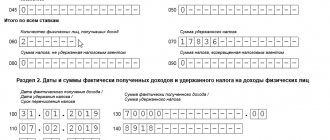Before sending the calculation using Form 6-NDFL and tax form, an accountant should check it himself. The correctness of the calculated and withheld personal income tax amount is checked. After the calculation is received by the Federal Tax Service, the tax inspector checks the control ratios and also reconciles the data in the calculation with the data presented in the 2-NDFL certificates and income tax returns. Knowing how the tax office checks 6-NDFL, the company can check it independently before sending the calculation. In this case, it will be possible to avoid troubles associated with additional tax assessment or the imposition of fines and penalties.
How the tax office checks 6-NDFL
Since 2021, the 6-NDFL form has been radically updated by order of the Federal Tax Service of Russia dated October 15, 2020 No. ED-7-11 / [email protected]
ConsultantPlus experts in their review spoke in detail about the main changes in the 6-NDFL report since 2021. If you do not have access to the K+ system, get a trial demo access for free.
The camera room is held directly within the walls of the tax authority, without visiting the tax agent. This type of verification lasts for 3 months from the date of submission of the calculation (Clause 2 of Article 88 of the Tax Code of the Russian Federation).
Data analysis occurs within the calculation, as well as in comparison with the card of settlements with the budget and other reports submitted to the Federal Tax Service, for example, ERSV, reconciliation of the data of these reports is carried out according to the control ratios from the letter of the Federal Tax Service dated February 19, 2021 No. BS-4-11/ [ email protected] /
Let's list what control ratios tax authorities use to find inconsistencies in the calculation of 6-NDFL:
- The date of submission of the calculation, recorded by the tax authority on the title page, is tracked. It must not be later established by law.
- The value on line 110 must be greater than or equal to the value on line 130.
- The value on line 140 must be greater than or equal to the value on line 150.
- The following equality must be observed: line 140 = line 100 × (line 110 – line 130).
Note that the equality of lines 140 and 160 should not be observed, since personal income tax can be accrued in one period and withheld in another. For example, if employees' salaries are paid the next month after the month in which they were accrued. In such a situation, personal income tax on wages for the last month of the quarter is calculated in one quarter, and is withheld and transferred to the budget in the next.
Tax officials also reconcile the data in 6-NDFL with the ERSV. ConsultantPlus experts explained what to do if a gap is identified between reports. Get free demo access to K+ and go to the Ready Solution to see expert recommendations.
Get ready for a desk audit of 6-NDFL!
The ingenuity of tax authorities in collecting fines from tax agents can only be envied. With the advent of the new reporting form 6-NDFL, there are real opportunities for tax authorities to collect fines in the amount of 20 percent under Article 123 of the Tax Code of the Russian Federation for late transfer of tax amounts. But since, by virtue of paragraph 3 of Article 108 of the Tax Code of the Russian Federation, it is impossible to hold a person accountable for violating tax laws without a decision from the tax authority, tax officials are now seeking to make such decisions as part of a desk audit of 6-NDFL.
For a uniform approach and, apparently, to facilitate desk audits, the Ministry of Finance of the Russian Federation and the Federal Tax Service of the Russian Federation sent a letter dated March 10, 2016 No. BS-4-11/ [email protected] “On the direction of control ratios” to lower tax authorities. Appendix No. 1.1 of this guide to action reflects certain positions of the submitted tax returns (including 6-NDFL), possible identified violations of the law, the wording of such violations, as well as further actions of the inspector. This is a kind of ABC for inspectors conducting desk inspections. Paragraph 2 of this “ABC” indicates the use of inter-document KS (control ratios) and tax reporting of the CRSB NA during desk audits of personal income tax. The directory of abbreviations makes it clear to us that KRSB NA is a card for settlements with the tax agent’s budget.
Let us dwell on paragraph 2.2 of the “ABC for tax authorities.” It concerns the date of personal income tax transfer, indicated on line 120 of the 6-personal income tax calculation, which inspectors are instructed to check with the actual date of payment in the CRSB NA. If a later payment is detected, after sending a written notification to the tax agent (clause 3 of Article 88 of the Tax Code of the Russian Federation), it is proposed to record the fact of violation of the legislation on taxes and fees (namely Article 226, Article 23, Article 24 of the Tax Code of the Russian Federation) in the inspection report in accordance with Art. 100 Tax Code of the Russian Federation. It is obvious that the further goal of the inspectors is a decision to collect a fine from the tax agent under Article 123 of the Tax Code of the Russian Federation.
Now, let’s look at it, as they say, point by point. Quote from the above “alphabet”: “if the date on line 120 < [less – approx. author] of the date of transfer according to the KRSB NA data (the date of payment of the personal income tax amount on line 140), then there may be a violation of the deadline for transferring the withheld personal income tax amount.”
Here's what you can say to this. KRSB NA - a card of settlements with the budget, or a taxpayer’s personal account maintained by the tax authority, is a form of internal control of tax authorities in pursuance of departmental documents in accordance with the order of the Federal Tax Service of the Russian Federation dated March 16, 2007 N MM-3-10 / [email protected] “On approval of Recommendations on the procedure for maintaining the “Settlements with the Budget” database in the tax authorities. The specified document became invalid due to the publication of Order of the Federal Tax Service of the Russian Federation dated 02.27.2010 N MM-7-1/ [email protected] in accordance with the Letter of the Ministry of Justice of Russia dated 01.20.2010 N 01-346/10. The fact that, due to the lack of regulatory regulation of relevant issues, tax authorities continue to be guided by it in practice does not give this document legal force.
The Resolution of the FAS TsO dated May 18, 2010 in case No. A14-8026/2009/195/28 states that “according to the legal position of the Supreme Arbitration Court of the Russian Federation, expressed in the Resolution of the Presidium dated November 5, 2002 No. 6294/01, a reflection of the presence and repayment of the payer's debt on personal accounts maintained by the tax authorities is not recognized as a legal fact with which tax legislation associates certain legal consequences for the taxpayer; a personal account maintained by the tax authority is a form of internal control exercised by it in pursuance of departmental documents.” This position is confirmed by the Ruling of the Supreme Arbitration Court of the Russian Federation dated October 7, 2011 N VAS-12547/11 in case No. A40-143957/10-116-650 . Thus, it has been confirmed with the judicial authorities that the use of information on personal income tax from the tax agents’ information tax service is for reference only and does not in itself have legal consequences for payers.
And now about paragraph 2.2 of the above-mentioned letter “On the direction of control ratios”:
“In accordance with paragraph 3 of Art. 88 of the Tax Code of the Russian Federation, send a written notification to [tax agents – approx. Author] about identified errors, contradictions, inconsistencies with the requirement to provide the necessary explanations within five days or make appropriate corrections within the prescribed period...”
Let's define the terms. An error is an unintentional deviation from correct actions... (Wikipedia). Accordingly, in the case of the indicator of line 120 of the 6-NDFL calculation, the error will be the tax agent’s incorrect execution of the Procedure for filling out, approved by order of the Federal Tax Service of the Russian Federation dated October 14, 2015 No. MMV [email protected] , which states that “line 120 indicates the date no later than which must the amount of tax must be transferred."
Actually, this date is called the established deadline for paying the tax and it has nothing to do with the date of actual payment of the tax. If the tax payment deadline is indicated by the tax agent in 6-NDFL in accordance with the deadlines established by paragraph 6 of Article 226 of the Tax Code of the Russian Federation, then there is no error on line 120 in the calculation. A contradiction is a relationship between two propositions, each of which is a negation of the other (Wikipedia). In itself, the established date for payment of the tax cannot contradict the date of the actual transfer of this tax, since they record absolutely two different legal facts. The deadline (date) for tax payment means for the taxpayer the emergence of obligations to pay tax (clause 1 of Article 44 of the Tax Code of the Russian Federation). The deadline (date) for transferring the tax means the termination of the taxpayer’s obligations to pay the tax. It is clear that a taxpayer can fulfill the obligation to pay tax both on time and ahead of schedule (clause 1 of Article 45 of the Tax Code of the Russian Federation).
Inconsistency is a lack of correspondence, a contradiction (Wiktionary). In the case of line 120 of form 6-NDFL, it may occur in the event of non-compliance by the tax agent with the norms of the Tax Code of the Russian Federation (non-compliance with them) when indicating the deadline for transferring the tax. And again, we are NOT talking about the date of actual transfer of personal income tax amounts.
So, let's summarize. The procedure for comparing, during a desk audit of the calculation of 6-NDFL, the date on line 120 with the date of transfer according to the KRSB NA data (the date of payment of the personal income tax amount) in order to establish a tax offense is unlawful for the following reasons.
A desk audit involves identifying errors, contradictions, and inconsistencies in tax returns. Form 6-NDFL is called “Calculation of the amounts of personal income tax calculated and withheld by the tax agent.” Consequently, only calculation indicators related to the calculation and withholding of personal income tax are subject to verification. Since the tax amounts paid by the tax agent, as well as the payment dates , are not the subject of display in this calculation, they have nothing to do with the desk audit of the tax authority.
A tax agent budget settlement card (CRSB NA) cannot be a confirmation of personal income tax information, since the maintenance of a tax agent budget settlement card (CRSB NA) is not based on legal norms, taxpayer personal account cards are nothing more than a form of internal control of tax authorities carried out in pursuance of departmental documents, and the information contained in them does not entail legal consequences for tax agents.
A desk audit of the “control ratios” of the first 6-NDFL calculation provided by tax agents and the above arguments will help avoid tax liability under Article 123 of the Tax Code of the Russian Federation.
Checking compliance of forms 6-NDFL and 2-NDFL
Since 2-NDFL is submitted as part of the new 6-NDFL, the algorithms for identifying violations discussed below are applied for each report in the 6-NDFL form.
Checking the annual amount of accrued income:
- Select the tax rate.
- From 6-NDFL we take the value in line 110.
- In 2-NDFL, we summarize the values of the lines “Total amount of income” for all individuals.
Checking the amount of accrued dividends:
- From 6-NDFL we take the value in line 111.
- In 2-NDFL, we summarize the values by income code 1010 for all individuals.
- Equality must be observed: item 1 = item 2.
Checking the annual amount of calculated tax:
- Select the tax rate.
- From 6-NDFL we take the value in line 140.
- In 2-NDFL, we summarize the values of the line “Tax amount calculated” for all individuals.
Checking the total number of individuals who received income:
- From 6-NDFL we take the value in line 120.
- We count the number of 2-NDFL certificates.
- Equality must be observed: item 1 = item 2.
Read about what discrepancies are normal for 6-NDFL and 2-NDFL in this material.
Read more about control ratios for checking 6-NDFL here.
Control ratios
When conducting a desk audit of 6-NDFL, a tax official checks the correctness of the amounts accrued and indicated in the document. He compares the specified data with the information that federal service employees have exclusively for internal use . The following indicators are meant:
- The date indicated on the cover page of the form - if the report is submitted untimely, the taxpayer faces penalties.
- The value indicated in column 020 (accrued income) should not exceed the value indicated in column 030 (tax deductions). However, equal values in these two columns are allowed.
- The value indicated in column 040 (accrued tax) should not exceed the value indicated in column 050 (fixed advance payment). As with the previous control ratio, equal values of indicators in these columns are allowed.
- The value indicated in column 040 is calculated using the following formula: 010 x (020 – 030) = 040.
- The values of columns 040 and 070 should not be equal, since personal income tax should not be accrued in one tax period, but withheld in another.
- The amount of payments transferred to the current account must correspond to the difference between lines 070 and 090.
- The tax payment date must not be later than the date indicated in line 120.
Important! If during the audit the tax authorities do not find any errors in the calculation on Form 6-NDFL, then the desk audit is completed. But if the tax inspector has any questions, he draws up a report based on the results of the audit.
Consequences of a desk audit for legal entities
If your calculation of 6-NDFL did not raise any questions from the tax authorities, then no further events will occur after the audit. However, if any discrepancies are identified, you will be notified and asked questions. You will have to answer them, explaining the correctness of your actions when filling out the calculation, or submit an updated report that eliminates the mistakes made.
Personal income tax agents who violate the rules for entering data into the report face the following penalties:
- If a tax agent submits a calculation with incorrect data to the inspectorate, he will be subject to a fine of 500 rubles. according to Art. 126.1 Tax Code of the Russian Federation.
- If, as a result of checking the calculation, an underpayment of tax is revealed, a fine equal to 20% of the amount owed may be imposed by decision of the tax authority (Article 123 of the Tax Code of the Russian Federation). Tax officials will also send a demand for payment of arrears and the corresponding amount of penalties. The amount of penalties depends on the amount of arrears and the length of delay.
Read about common difficulties when preparing calculations in the publication “How to check 6-NDFL for errors?”
Correcting errors in 6-NDFL
Important! If during a desk audit the tax inspector discovers errors or inconsistencies, the taxpayer is obliged to correct them. Corrections must be made within 5 business days from the date of receipt of the notification from the tax authority.
Tax officials check the deadlines for payment of personal income tax, while considering those indicated in the calculation and checking them with those indicated in the personal cards of the company or individual entrepreneur. Such cards are kept specially; they are necessary to verify the timely payment of taxes to the budget.
If during the camerawork it is discovered that the amount required for payment has not been transferred, the inspector will point this out to the taxpayer. The company or individual entrepreneur is required to eliminate this within 8 working days from the date of receipt of the relevant notification from the tax office.
When submitting a 6-NDFL calculation with errors, the taxpayer will have to correct them, and in addition to this, also pay a fine. The fine for a report submitted with errors will be 500 rubles.
Failure to submit Form 6-NDFL on time will result in a fine of 1,000 rubles for each month of delay. If it turns out that a company or individual entrepreneur has not paid some part of the tax, then he will need:
- pay the remaining balance;
- pay a fine equal to 20% of the debt amount;
- pay penalties in an amount depending on the time of delay in payment and the amount of debt.
In this case, the tax authority will send a notification to the taxpayer, which will indicate all the amounts that must be paid.
Important! If during the year the tax agent did not transfer funds to individuals, then the zero calculation in Form 6-NDFL will not need to be submitted to the tax office. If payments were not transferred to individuals only for a certain period, then the columns corresponding to it will remain empty, and the rest will be filled in.
Thus, a desk audit of 6-NFDL is carried out on the basis of those documents provided by the tax agent - an organization or individual entrepreneur. Particular attention is paid to amounts transferred to individuals, for example, wages or dividends.
Results
A desk audit of the 6-NDFL calculation will go unnoticed for you if you followed the rules for calculating and paying tax, as well as filling out the form.
If an accountant finds an error in his calculation on his own, he can send an updated form to the inspectorate. He will have to do the same if the tax authority reveals an error, but in this case penalties may be applied. You can find more complete information on the topic in ConsultantPlus. Free trial access to the system for 2 days.
On-site inspections of individuals
FL also conducts on-site inspections.
Who are these FLs? These are former individual entrepreneurs. Individual entrepreneurs, closing their activities, try to evade tax audits or taxes and fines that were previously assessed. The opinion that a physical identity cannot be verified during an on-site inspection is erroneous.
In the Tax Code of the Russian Federation there is no prohibition on checking personal income. And if a former individual entrepreneur made mistakes in his activities that resulted in concealment of income and non-payment of taxes, he will be verified as an individual entrepreneur for the period of his activity as an individual entrepreneur, and all taxes and penalties will be additionally assessed on the individual entrepreneur. In addition, old debts from doing business will also need to be paid.
Connecting control ratios
You can carry out such work as checking whether the calculation of 6-NDFL is correct using control ratios. Control ratios are a sequence of mathematical calculations between certain lines that must coincide with other report indicators, that is, all calculations encrypted in the report lines must, when crossed, give the corresponding results. The organization is not obliged to check the control ratios of 6-NDFL (for the 3rd quarter of 2021, by the way, they will probably differ compared to the 1st quarter of the same year). This procedure is advisory in nature to eliminate elementary errors in the report made by the accountant. Some new accounting programs already include an option such as “check form 6-NDFL”, that is, automatic verification of information entered in the lines of the report for compliance with control ratios. As a result of the analysis, the program offers options for adjusting the data. However, it is recommended to take such a step as checking 6-NDFL yourself, recalculating several or all control ratios manually on a calculator - this will protect the accountant from making adjustments. The letter from the tax service contains twelve points of those indicators, the discrepancy of which will cause additional clarifications from the tax authorities. Here are some of them:
- the actual date of filing 6-NDFL coincides with the date indicated on the title page of the report;
- the calculated value of total income indicated in line 20 must be no less than the value of total deductions on line 30;
- the value of line 40 must correspond to the result of the following operations: the difference between lines 20 and 30 *line 10/100;
- the value from line 40 must be no less than the value from line 50;
- the total amount contributed to the budget must be no less than the delta between the amount of personal income tax actually withheld (line 70) and the value of line 90 (refund to the payer) of the tax.
Returning to the question of how to check 6-NDFL, we will give an example of changes in control ratios. In previous editions of the letters, it was recommended to use 6-NDFL as a control ratio for checking: line 070 should be equal to the sum of lines 140. Let us recall that in line 70 the enterprise informs how much it withheld personal income tax, in line 140 - the same tax with distribution by dates of payment of all types of remuneration. Then the tax authorities changed their minds and admit that this control ratio is not always valid. An exception to the previously proposed ratio was the transfer of actual payments in the quarter following the accrual, for example, of wages. Therefore, some amounts do not fall into line 140 in the second part of the report. There is no violation of the law in this case: one quarter ends, the report is closed, and salaries are paid in the next quarter. Hence the discrepancy in the results according to the verification formula previously proposed by the tax authorities. Based on the assumption that some organizations calculate and pay salaries according to this scheme, the Federal Tax Service excluded this control ratio from the list of mandatory ones. The department confirmed on its official website that this ratio is not mandatory. Therefore, in order to perform such an operation as checking 6-NDFL for 2021 (for any reporting period of this year), there is no need to apply this control ratio. If the accountant nevertheless decides to conduct a more pedantic study of the report being prepared for submission, we remind you that the difference in the values of the highlighted lines is the amount of the actual payment of remuneration on which tax was accrued in the current reporting period, and the payment will be made in the next quarter.
Subjects and objects of desk inspection
Desk audits are carried out by territorial tax authorities, and the subjects of the audit are:
- institutions, organizations;
- commercial, manufacturing companies, regardless of the form of economic organization;
- individual entrepreneurs;
- cooperatives, unitary enterprises;
- joint ventures.
The object of the desk audit is the activities of a company or individual entrepreneur (its inactivity) in terms of proper accounting of the income of employees and other individuals, as well as the correctness of calculation, withholding and transfer of personal income tax to the budget.







